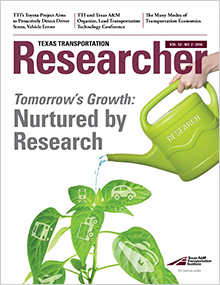Growth is a good thing. In economic terms, it can mean increased opportunity for businesses and more choices for consumers. But economic growth also means more demands on — and often more congestion for — our transportation system. Sometimes, the rate of economic expansion can outpace the capacity of our transportation infrastructure.
In its 2013 report Freight and Economic Development: Driving the Texas Economy, the Texas Freight Advisory Committee noted that for the Lone Star State to stay competitive economically, “the right freight transportation infrastructure is absolutely essential to enable businesses” to compete. This report was followed up by the Texas Freight Mobility Plan adopted by the Texas Transportation Commission in early 2016.
As Texas continues to grow and people’s buying habits evolve, the Texas Department of Transportation (TxDOT) is assessing the best ways to meet the state’s future freight needs. Recent changes in consumer purchasing resulting in more direct home-package delivery are dramatically changing distribution patterns, increasing the number of intercity and local delivery trucks on Texas roadways. Emerging freight delivery technologies and innovative operational freight strategies offer the potential to use available infrastructure more efficiently.
“Others around the globe are doing really innovative things to move freight efficiently, reliably and safely,” says Curtis Morgan, manager of the Texas A&M Transportation Institute’s (TTI’s) Multimodal Freight Program. “We’ve looked at many of those possible options for TxDOT and evaluated them in the context of what’s most effective for Texas.”
Project 0-6837, Assessment of Innovative and Automated Freight Systems and Development of Evaluation Tools, is part of TxDOT’s Innovative Research Projects Program. The program is aimed at proactively addressing issues before they become problems. Based on the findings of recent assessments by TTI and others, many would argue that some aspects of freight movement in Texas are already problematic.
“Congestion resulting from inadequate capacity is already an issue according to Texas business leaders, and if we don’t adopt new strategies to improve freight mobility, the problem’s only going to get worse,” explains Morgan. “Manufacturers are also trying to get more goods to market than ever before. In the end, someone — usually the consumer — has to pay for any shipping inefficiencies.”
In phase 1 of the project, Morgan and his team researched 57 potential innovative and automated freight-system strategies and technologies to identify lessons learned around the globe. They looked at what worked where and how much it cost to implement. Most importantly, they evaluated whether or not a given strategy or technology could meet the specific needs of Texas.
Potential solutions to enhancing freight movement include automation (like truck platooning), dedicated roadways for trucks to alleviate delays due to congestion, signal coordination systems that prioritize freight movement in corridors, and alternative-fuel vehicles that would benefit both a shipper’s bottom line and the state’s environment. Researchers considered solutions involving air, land and sea legs of the shipping process. Phase 1 selection criteria included:
- documenting the implementation history of each technology in the United States and worldwide;
- identifying the prospective institutional barriers to U.S. and Texas implementation;
- estimating the cost relative to other, more traditional transportation-system projects; and
- cross-referencing each proposed strategy/technology with Texas’ freight needs identified in the draft Texas Freight Mobility Plan, the current Texas Rail Plan Update, other TxDOT modal plans, and major freight planning efforts of Texas metropolitan planning organizations.
“Texas is a very diverse state with a wide array of needs. Not every option applies to every situation,” says Morgan. “Freight improvement needs vary from rural to urban communities, from seaports to airports, and from short-haul to long-haul shipping.”
Researchers narrowed down the options by applying screening criteria, analyzing and ranking potential solutions with the help of subject-matter experts, and discussing options with the TxDOT project team. Out of the nearly five dozen potential solutions studied, nine strategies/technologies were selected by the TxDOT panel and will be further investigated in phase 2 of the project:
- automated, zero-emission freight systems;
- freight rail public-private partnerships;
- natural gas, electric/hybrid, and other alternative fuel freight vehicles;
- truck-shipper matching systems;
- port intelligent transportation systems;
- separation of trucks from automobiles;
- truck parking information systems;
- freight village facility development; and
- border advanced freight traveler information.
Each will be analyzed for evaluation as long-term TxDOT implementation alternatives to address specific freight-system needs.
“TTI’s expertise has helped us identify the most promising strategies and technologies for moving freight in the future,” states Wade Odell, research engineer with TxDOT’s Research and Technology Implementation Office. “We look forward to working with TTI to refine those recommendations in the second phase of the project.”


